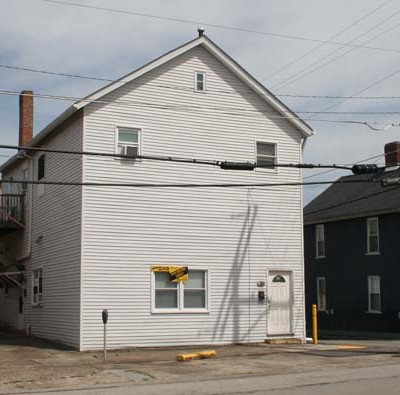
California is a borough in Washington County. It was settled along a bend in the Monongahela River in 1849 and incorporated as a borough in 1853. It became a major shipbuilding center for a time and was later an important coal-producing region.
By the turn of the century, approximately 20 Jewish families lived in California. They initially prayed in private homes or with existing congregations in nearby towns—most likely Brownsville and Charleroi—until 1913, when they founded Sons of Jacob Congregation, according to a 1939 survey from the Works Progress Administration Church Archives. They incorporated the Orthodox congregation on February 20, 1914, according to One Hundred Years of Progress of California, Pennsylvania: 1849-1949, which lists the charter members as Max Avner, Nathan Avner, Louis Kotler, Samuel Z. Winer, Lewis Nevins, Abe Harris, Bennie Itskovitz, Phillip Caplan and Harry Silver.
Through the efforts of four members—Harry Abramson, Morris Goldman, Max Kotler and Louis Zacks—Sons of Jacob renovated a two-story building at 230 Liberty Street to use as a synagogue. By the time of an American Jewish Yearbook survey in 1920, the congregation operated a daily cheder (religious school) with one teacher and 15 students.
Despite small membership, Sons of Jacob supported a rabbi for its early existence. Rabbi Simon Baron led the congregation from 1913 to 1918. Rabbi Alex Spokane was leading the congregation in 1926. Rabbi Israel Becker was leading the congregation at the time of the WPA survey in 1939. The two-story synagogue on Liberty Street included a sanctuary on the first floor and a private dwelling on the second floor for the rabbi.
The growth of what is now known as PennWest University-California helped the California borough continue to grow into the 21st century, as many other small towns throughout Western Pennsylvania shrank. A former building at the campus, Azorsky Hall, is named for Sons of Jacob congregant Dr. Abraham Azorsky, who was a local chiropractor and served as president of the school’s board of trustees from 1968 to 1970.
Information about the later years of Sons of Jacob is scarce. A November 1971 article from the Jewish Chronicle suggests that the congregation may have remained a going concern throughout the 1960s. At some point after that, the six remaining members of Sons of Jacob dissolved the congregation, according to recollections from Morley Azorsky included in the Western Pennsylvania Synagogue Documentation Project in 1999. The proceeds were divided between the United Jewish Federation of Pittsburgh and the Jewish community in Brownsville. The former Sons of Jacob synagogue on Liberty Street was later converted into apartments and remained standing as of 2014.
A group called the Daughters of Jacob Society was organizing Bible classes and holiday entertainments by 1914 and appears to have evolved into a Hebrew Ladies Aid Society of California during World War I.
The National Council of Jewish Women-Pittsburgh Section organized a religious school in California in late 1915. The school was the 16th chapter in the regional education initiative that later became the Southwestern District of Pittsburgh Jewish Religious School Program.
Along with communities in Brownsville, Charleroi, Coal Centre, Roscoe and other small towns in the Monongahela River valley, the California community started a Young Men’s Hebrew Association in January 1915 with H. L. Levy serving as chairman and Frank H. Weiss a pro tempore secretary.
| Type | Year | Population | Source |
|---|---|---|---|
| Total population [California] | 1860 | 476 | U.S. Census via Wikipedia |
| Total population [California] | 1870 | 659 | U.S. Census via Wikipedia |
| Total population [California] | 1880 | 1,009 | U.S. Census via Wikipedia |
| Total population [California] | 1890 | 1,024 | U.S. Census via Wikipedia |
| Total population [California] | 1900 | 2,009 | U.S. Census via Wikipedia |
| Total population [California] | 1910 | 2,230 | U.S. Census via Wikipedia |
| Jewish population [California] | 1919 | 117 | American Jewish Yearbook, Vol. 21 [1919-1920] |
| Total population [California] | 1920 | 2,480 | U.S. Census via Wikipedia |
| Jewish population [California] | 1927 | 111 | American Jewish Yearbook, Vol. 30 [1928-1929] |
| Total population [California] | 1930 | 2,362 | U.S. Census via Wikipedia |
| Jewish population [California] | 1937 | 75 | American Jewish Yearbook, Vol. 42 [1940-1941] |
| Total population [California] | 1940 | 2,614 | U.S. Census via Wikipedia |
| Total population [California] | 1950 | 2,831 | U.S. Census via Wikipedia |
| Total population [California] | 1960 | 5,978 | U.S. Census via Wikipedia |
| Total population [California] | 1970 | 6,635 | U.S. Census via Wikipedia |
| Total population [California] | 1980 | 5,703 | U.S. Census via Wikipedia |
| Total population [California] | 1990 | 5,748 | U.S. Census via Wikipedia |
| Total population [California] | 2000 | 5,274 | U.S. Census via Wikipedia |
| Total population [California] | 2010 | 6,795 | U.S. Census via Wikipedia |
| Total population [California] | 2020 | 5,479 | U.S. Census via Wikipedia |